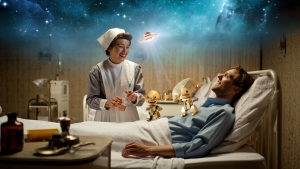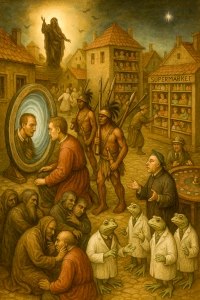Is Science the Pacifier of Modern Man?
✨ Epiphany Singing in the 17th Century ✨
A vivid depiction of the traditional “Three Kings Singing,” a custom in the Low Countries where singers—often children dressed as the Magi—went door to door with a star and songs, hoping for coins or sweets in return. This festive scene, painted in the 17th century, shows the social dynamics of the time: costumed singers on the street, and well-dressed ladies observing from their doorsteps.
In Catholic regions, Epiphany (January 6) celebrated the revelation of Christ to the world. But in many Protestant areas of the Netherlands, the holiday was viewed with suspicion or even disdain. Reformers criticized it as a symbol of papal excess—and some even associated the opulence of Epiphany celebrations with the figure of the Antichrist.
Painting: Anonymous Flemish artist, 17th century – Scene of “Driekoningenzingen”
Science as Modern Consolation
In today’s rapidly changing world, science is often seen as a beacon of certainty and stability. Many people turn to scientific discoveries and technological advances to ease their worries and fears. This tendency can be compared to a pacifier comforting a baby, with science being praised as the ultimate savior of humanity.
Contemporary society has a remarkably high level of trust in science and technology. Scientific methods are seen as rational, reliable ways to address the complex problems of our time. From climate change to pandemics, many of today’s challenges are being explored and addressed through scientific research. People gain security from the idea that there is always a scientific solution in sight, which gives them a sense of security and control.
However, this confidence raises the question of whether science really always has the answers, or whether it merely creates an illusion of security. Science is, by definition, an ongoing process of hypothesis and verification, meaning that new discoveries can refute or complicate previous assumptions. Furthermore, science is influenced by human limitations and biases, so the image of an objective savior can sometimes be an oversimplification.
In addition, technological innovations often lead to new ethical and social issues. While science and technology have the potential to solve problems, they also create new challenges that must be carefully balanced. It is essential to remain critical of how science is deployed and understood in our society, and to recognize that science is not always a panacea, but a tool to be used with wisdom and ethical awareness.
The Role of Science in Alarm Signals
Science plays a crucial role in identifying and communicating impending threats that could affect modern humanity. From climate change to pandemics, scientific insights often serve as early warnings for policymakers and the public. Through detailed research and data analysis, scientists can predict developments and provide warning signals that might otherwise be overlooked.
A recent example of this crucial role is the COVID-19 pandemic. Scientists worldwide raised the alarm about the potential devastation of the virus even before it spread globally. Rapid genetic sequencing of the virus and epidemiological modeling allowed them to make warnings and policy recommendations that were potentially life-saving. This emphasises the importance of scientific advice in managing risks and taking precautions.
The influence of the scientific community is also felt in the area of climate change. By closely monitoring environmental changes, such as rising sea levels and melting ice caps, scientists can gather tangible data provide information that enables policymakers to take more decisive action. These predictions are often based on complex models that take into account multiple factors, from greenhouse gas emissions to human activities.
Nevertheless, the question arises whether too much is expected of scientists to alert us in a timely manner to impending dangers. Scientists often find themselves in a delicate position, balanced between the desire for precision and the urgency of communication. This can lead to tensions, especially when scientific warnings clash with economic and political interests. Moreover, public perception of scientific uncertainty can undermine the effectiveness of the message.
While the scientific community has achieved much in acting as an early warning system, it remains a shared responsibility. Scientists can sound the alarm, but it also takes the cooperation of governments, businesses and the public to actually take action. Only through this synergy can the message of science be effectively translated into effective measures.
Self-Reflection Within Science
Science is a dynamic field, constantly changing and subject to changes that can have profound consequences for our knowledge and insights. Historically, there have been many moments when science has radically renewed itself. One of the most remarkable changes occurred during the Scientific Revolution of the 17th century, when thinkers such as Copernicus, Galileo, and Newton overturned old assumptions and laid the foundations for modern physics and astronomy.
The question that now arises is whether we are on the eve of a new paradigm shift in science. With rapid developments in technology, such as artificial intelligence and bioengineering, the boundaries of science are constantly being pushed. There is a growing realization that to discover hard truths, the scientific community must be more willing than ever to re-evaluate its fundamental assumptions. Scientists must be open to innovative ideas that challenge the current consensus and have the courage to defend bold new propositions.
This self-reflection within science is not without challenges. Progress is often hampered by institutional and academic rigidity, where unorthodox ideas are more difficult to accept. Nevertheless, there are encouraging signs of change. Increasingly, we see multidisciplinary collaborations and open-access publishing platforms that promote the exchange of radical new ideas. Moreover, there is an increasing emphasis on scientific integrity and transparency, which lays the foundation for more reflexive and adaptive scientific practices.
Whether science is really becoming the pacifier of modern man depends largely on its capacity for self-criticism and flexibility. History teaches us that the most groundbreaking discoveries often come from a period of intense self-reflection and a willingness to explore the unknown. If the scientific community takes these lessons to heart, the future of science can be more inspiring and substantial than ever before.
Rethinking the Big Bang and Einstein
The concept of the Big Bang as the beginning of our universe has formed the basis of cosmology for decades, while Einstein’s theory of relativity has become a cornerstone of physics. Although both theories have received much empirical support, the demand for critical revision grows over time. Science is characterized by an ever-advancing understanding of reality, and radically new ideas are always welcome.
The process of rethinking established scientific theories presents both challenges and opportunities. Historically, there have been moments when fundamental changes in scientific thinking occurred, such as the transition from the Ptolemaic worldview to the heliocentric model of Copernicus, or the replacement of Newtonian mechanics by Einstein’s theory of relativity. These paradigm shifts demonstrated that the scientific community, while slow to accept new ideas, is ultimately open to transformative concepts.
The possibility of revision is closely linked to the availability of new data and technology. Modern instruments such as the Hubble Space Telescope and the Large Hadron Collider have allowed us to observe phenomena that were previously unthinkable. The insights gained from this have led some scientists to propose alternative theories, such as the idea of a multiverse or emergent gravity as a replacement for dark matter and dark energy.
The implications of such changes would be enormous, not only for our understanding of the universe, but also for technological and philosophical advances. Rethinking the Big Bang and relative theories requires an open mind and a willingness to let go of established views. While some may see this as a threat to existing scientific orthodoxy, it also holds the potential for a deeper understanding of the laws of nature and our place within the cosmic whole.
The Limitations of Scientific Instruments
When we consider the role of scientific instruments such as microscopes and telescopes, the question arises: are these devices merely reflections of our imagination, or do they provide us with a real window into the real world? This is an issue that presents both scientists and philosophers with challenging perspectives on the reliability of our observations.
First of all, we must acknowledge that scientific instruments are not perfect. Every microscope, telescope or spectrometer has inherent limitations. For example, a microscope can give us a detailed view of a cell, but the image we see depends on the resolution and technology of the device. What if, due to technological limitations, we only perceive a fragmented or distorted version of reality? These limited observations can hinder our knowledge and even lead us astray.
Furthermore, it is important to realize that our interpretations of what we perceive are always colored by our preconceived beliefs and expectations. The philosophical implication of this is that our attempts to create order and structure in the world may be based on illusions. When we view the world through a scientific instrument, do we see reality or simply a construct we understand within the limitations of our technology?
This line of thought leads to a critical question about the nature of science itself. Is science the ultimate source of truth, or is it merely a complex system of hypotheses and models that help us make sense of the chaos around us? It is undeniable that scientific instruments allow us to see beyond our senses, but it remains essential to be aware of their limitations and their potential impact on our understanding of reality.
From Order to Chaos and Vice Versa
Science aims to create order in a seemingly chaotic world. Scientists use methodical approaches and rigorous analysis to discover patterns hidden in chaos. This process of organizing often begins with observation and hypothesis formation, followed by controlled experiments and data analysis. Through these steps, scientists attempt to develop universal principles and laws that govern the natural sciences.
However, the pursuit of order is a complex and dynamic process. As scientists learn more about nature, they are often confronted with new layers of complexity and unpredictability. This can be seen in areas such as quantum mechanics, where particles behave in unpredictable and seemingly chaotic ways, and in meteorology, where weather patterns often appear to behave anarchically despite accurate modeling and predictions.
Interestingly, there is a cyclical nature to the interaction between order and chaos. Scientific insights can initially transform chaos into ordered knowledge, but these structures can in turn reveal new forms of chaos. This cycle may be a reflection of the inherent complexity of the universe, where stability and disorder constantly interact. The work of pioneers such as Edward Lorenz with his discovery of the ‘butterfly effect’ in weather, and Benoit Mandelbrot with his fractal geometry, illustrates how deep patterns can lie hidden in apparent chaos.
In summary, the relationship between order and chaos in science is both fascinating and fundamental. While science focuses on mapping the natural world, balancing order and chaos remains an ongoing challenge. This dynamic relationship drives the continuity of scientific inquiry and reflects the complex nature of the reality we seek to understand. Recognizing this duality allows us to gain deeper insights into both nature and the role of science.
Human experience has always been characterized by the constant search for order and understanding. The question arises, however, whether our eyes are able to discern the objective truth and transcend our reality, or whether we will remain forever trapped in the armor of our flesh and blood.
The Limitations of Human Perception
Historically, human observations have often led to misconceptions about the nature of the universe. In the Middle Ages, the universe was viewed as a complex mechanical system, comparable to the technology of the time, such as Meccano. This idea was largely influenced by the state of science and technology at that time. This way of thinking limited people’s understanding of the true complexity of the cosmos.
The inventions of new technologies have significantly expanded our understanding of reality. When Christiaan Huygens developed the microscope, the scientific focus shifted to the microcosm. This shift opened up new perspectives and allowed scientists to push ideological boundaries. These learned insights ultimately contributed to the Enlightenment.
The relationship between our perceptions and reality has philosophical implications. One might wonder whether we are not still approaching the cosmos as a body of flesh and blood, projecting our own bodily limitations onto our theoretical models. The ongoing innovation in science and technology continues to challenge this perception, but it is important to recognize that each new step in perception reveals only one aspect of reality.
In essence, as we engage in the efforts to continually readjust everything to maintain a restful order, the central question remains whether we can ever achieve full understanding of the cosmos, or whether each new discovery merely serves to reveal another layer of mystery. As the saying goes, “You can die from anything, especially from living,” this statement underscores the ironic, sometimes tragic aspect of our endless quest for knowledge and understanding.






